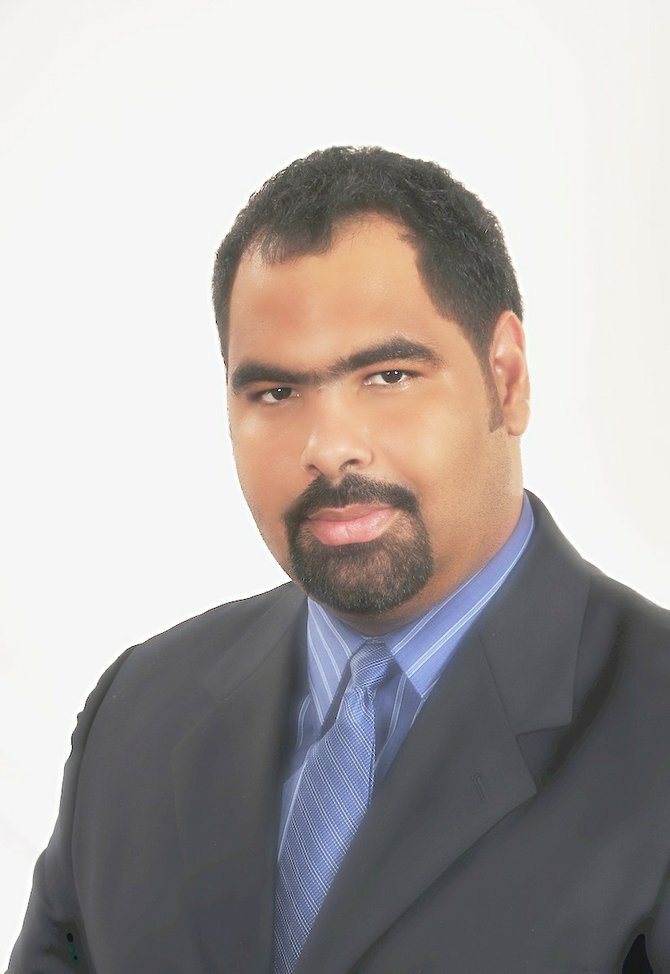By Neil Hartnell
Tribune Business Editor
nhartnell@tribunemedia.net
A BISX-listed bank yesterday said it is on target to beat 2018’s earnings growth and deliver $25m in full-year profits despite the absence of first quarter loan book expansion.
Gowon Bowe, pictured, Fidelity Bank (Bahamas) chief financial officer, told Tribune Business that its 8.8 percent net income growth to $6.833m for the three months to end-March 2019 was largely driven by increased interest income stemming from credit portfolio expansion in the prior year.
Emphasising that the commercial bank is focused on “steady growth on our asset base”, Mr Bowe said Fidelity’s main goal is to maintain return on equity (ROE) at around 25 percent to ensure its shareholders receive a strong return on their capital.
Disclosing that it will declare a substantial dividend in June, he added that Fidelity would finance the payout from profits generated over the 2019 first half as it awaits the windfall from the sale of its 50 percent equity stake in affiliate Royal Fidelity Merchant Bank & Trust.
Fidelity Bank (Bahamas) will receive $16.449m, plus half the investment bank’s undistributed earnings and retained earnings when that deal closes, but Mr Bowe said the institution was continuing to perform strongly - and remained on course to hit net income targets - without these proceeds.
“They’re trending still in the right direction, upwards,” he told Tribune Business of the 2019 first quarter results, adding that interest income growth generated by its $440m loan portfolio had “stabilised” since last year’s expansion and will now deliver “full-year benefits” for Fidelity.
Mr Bowe said the bank had “maintained our position” despite virtually zero growth in its loan portfolio since the 2018 year-end. He added that such an outcome was not unexpected, since the commercial banking industry generally experienced first quarter declines while there was also “more competition” in the shape of rivals’ loan campaigns.
“If we maintain the quality of loans we’re writing, and grow the book at a steady pace, we will certainly be looking at a very favourable 2019,” the Fidelity chief financial officer said. “The first quarter is tracking us in the right direction without any loan growth.”
Coming off a 2018 in which Fidelity had targeted 10 percent bottom line growth, Mr Bowe said the bank expected to beat that outcome this year - especially as it did not have to cope with changes to global accounting standards that previously resulted in a one-time increase to loan loss provisions.
“I wouldn’t say we will be super-aggressive, but we expect to exceed 10 percent this year,” he told Tribune Business. “In terms of dollar amount, we’re aiming for $25m this year.” The first quarter results have placed Fidelity on track to achieve this, with interest income up $1.5m or 10.3 percent at $16.554m.
“What is most important to us is maintaining the equity percentage,” Mr Bowe revealed. “Our loan book is not growing, but our return on equity is growing. We’re more concerned with ensuring return on equity is in the mid-20m percent range, which we’ve consistently done in the last couple of years.
“It means the capital deployed is delivering returns to the shareholders. Growth without profitability is not our target, and equally having profitability without steady growth that is sustainable is not our aim as well.... We want steady growth on the asset base, and our ultimate goal is to maintain return on equity in the range of 25 percent; we don’t mind a couple of percent either way.”
Reiterating that Fidelity will not sacrifice these goals for short-term profit gain, Mr Bowe said the expansion of its capital base was readying the commercial bank “to sustain loan growth going forward”.
With first-half profitability set to cover June’s dividend, he added that the bank’s capital was at a “comfortable” 21 percent of risk-weighted assets - just ahead of its 20 percent target.
“We are certainly aspiring to loan growth this year, even though I believe the economy and competitors will make it more difficult,” Mr Bowe told Tribune Business. “As you become a significant player in your target markets, and as you become bigger, the opportunity for growth is reduced.”
Fidelity’s cash holdings increased by a further $20m to $126.783m during the 2019 first quarter, and Mr Bowe said that while the bank was aware of the need to deploy these reserves into higher-yielding investments there was no cause for panic.
“We are conscious of the cash on the balance sheet,” he added, “but in the last six months we’ve been able to deploy some of that into earning interest. While the cash is growing, it gives us the flexibility on loan growth - it means we’re able to fund it organically, and with investments and private securities that meet our risk profile.
“The excess liquidity is a market phenomenon, but we believe the cash levels are comfortable and we can certainly manage them to maintain profitability.” Fidelity Bank (Bahamas) net equity stood at $96.701m at end-March 2019, with retained earnings accounting for just over $61m of this sum.





Comments
Use the comment form below to begin a discussion about this content.
Sign in to comment
Or login with:
OpenID